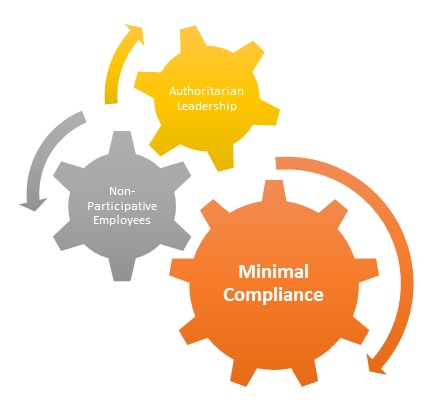- Business Concepts ›
- Human Resources (HR) ›
- Minimal Compliance
Minimal Compliance
Definition, Importance & Example
This article covers meaning & overview of Minimal Compliance from HRM perspective.
What is meant by Minimal Compliance?
Minimal compliance means minimum involvement in conducting anything. There can be many perspectives of what minimal compliance is. Minimal compliance can be defined in terms of employee behavior where employees only adhere to the instructions given by the organization to accomplish a task. Another perspective of minimal compliance can be in terms of decision making. An organization may take decisions keeping in mind the temporary situations and cost effectiveness.
Employees may not attach with it their own motivation and engagement levels to perform that job. An organization may think in terms of doing and taking decisions which will temporarily bring laurels to the organization. The concept of minimal compliance is very subjective in nature. It depends when it works well. If we take the decision making perspective of the concept, then it all depends on the market conditions which routes the decision for an organization. But if we take the employee behavior aspect of the concept, then non-involvement of the employees may lead to problems in near future for the organization.
Importance of Minimal Compliance
Minimal compliance holds good to understand the working culture of the organization. It also speaks a lot about the organizational structure. While we discussed about the two perspectives attached with minimal compliance, both the aspects hold equal importance in an organization. When it comes to employee behavior, if there is minimal compliance, then it is sure that the organization is a strictly hierarchical form of organization, where the people at the top positions just instruct the employees to do as they say. There is no such involvement of the employees in decision making process and the employees concern is not taken care of. It can be said as that of a part of hard HRM concept. It follows authoritarian leadership.
When taking in lieu the decision making perspective, one part of the analysis comes to a conclusion that there is no environment for participative decision making process. Another conclusion can also be that the organization is facing some problems and may be in an organizational decline phase, and must be trying to do things temporarily to save the organization from getting collapsed. But minimal compliance in general is not a very good approach to be sued in organizations. They may pose problems in times of crisis.

Advantages & Disadvantages of Minimal Compliance
Advantages are Minimal compliance are as follows:
1. Fast decision making process.
2. Top positions in an advantageous position.
3. Remedy for organizations in decline phase.
Certain disadvantages are:
1. Temporary solution.
2. Lack of employee participation
3. Authoritarian leadership style prevalent.
Example of Minimal Compliance
Suppose an organization is in a phase where it’s losing its market demand, so what the company can do is to increase sales of its products may lower the prices to adjust with the demand in market, or can come with various discount offers and coupons. These are all but temporary solutions to the problems and would not work well in future. The organization but has no option but to stick to such temporary remedial solutions. In case of approach considering employees’ behavior, an example can be taking decisions without asking their consent and just imposing upon them. Such impositions lead to higher attrition rates in organizations.
Hence, this concludes the definition of Minimal Compliance along with its overview.
This article has been researched & authored by the Business Concepts Team which comprises of MBA students, management professionals, and industry experts. It has been reviewed & published by the MBA Skool Team. The content on MBA Skool has been created for educational & academic purpose only.
Browse the definition and meaning of more similar terms. The Management Dictionary covers over 1800 business concepts from 5 categories.
Continue Reading:
What is MBA Skool?About Us
MBA Skool is a Knowledge Resource for Management Students, Aspirants & Professionals.
Business Courses
Quizzes & Skills
Quizzes test your expertise in business and Skill tests evaluate your management traits
Related Content
All Business Sections
Write for Us